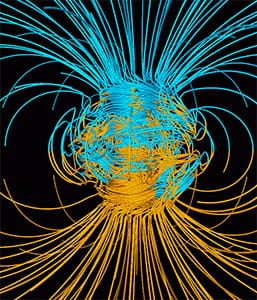Like many offshore sailors on watch at night, I dwell on all kinds of things. On clear nights in the Northern Hemisphere, I consistently look up at the North Star, roughly gauge its angle and orientation above the dark horizon and compare it with our GPS latitude. A quick look at the magnetic steering compass reassures me we’re on course. It’s not that I don’t trust our GPS or our compass; the North Star reminds me of an earlier time in life when, with an accurate clock, sextant, tables and all, I navigated our sloop safely on long passages without electronics. As we drift away from traditional offshore navigation skills, I’m reminded that perhaps there was a time in history when human beings were able to determine direction without the aid of a magnetic compass.
Man has long been amazed at animal and bird navigation. How do they migrate and find their way for thousands of miles? Think about the size of hummingbird and butterfly brains. Carrier pigeons are particularly amazing — they can find their way back to their home roost from faraway places they had never previously visited.
I’ve always believed man has an innate ability to use the Earth’s magnetic field to find direction. Out of curiosity, I Googled human and creature magnetoreception systems and waded through the huge amounts of recent literature on the subject. A few things stood out. Scientific consensus is that birds and animals, along with many other creatures, routinely navigate using the Earth’s magnetic field. Sometimes they rely on magnetite, (Fe3O4) which is a widely available iron oxide found in all living creatures including humans. Magnetite can detect the Earth’s magnetic field and send signals to the creature’s brain, which checks an internal map and sends any course-correction signals.
 |
|
The Arctic tern is a navigation champ, flying between the Arctic and Antarctic. |
|
AWeith/Wikipedia |
A second magnetoreception element is the protein crytpochrome that is housed in the retina of the eyes of all living creatures, humans included. It also reacts to the Earth’s magnetic field. Cryptochrome is particularly sensitive to low-frequency green or blue light. The importance of both detectors depends on the species.
The Earth’s magnetic field is an electric “field” measured at about 0.56 gauss and not an acceleration force like gravity (gn). When compared as forces that man can detect and utilize, the Earth’s magnetic field is about 100 times smaller than the force of gravity. Because the Earth’s magnetic field is a very low-intensity “field” and not a force, it gets easily lost among other natural and manmade electric fields occurring throughout our environment. Laboratory experiments with human detection of the magnetic field must be done in a very carefully controlled environment. Because the literature concluded that controlled experiments with humans were sometimes unrepeatable, my hopes were diminished: I wanted to learn that man could still navigate just like other creatures if we tried hard enough.
Only recently have biophysicists concluded that perhaps man does have the ability to navigate using the Earth’s magnetic field using magnetite, or more likely, the eye protein cryptochrome, but of course more research is needed. I visualize a special pair of high-tech glasses that help us “see” the Earth’s very weak magnetic field lines of force and determine magnetic north. I even donned a blindfold and walked in circles in my yard in hopes of detecting magnetic north! No definitive results.
While man has forgotten how to use his internal navigation capability, animals, insects, sea creatures and birds all have refined their use of the Earth’s magnetic field, the sun and other sensory factors.

